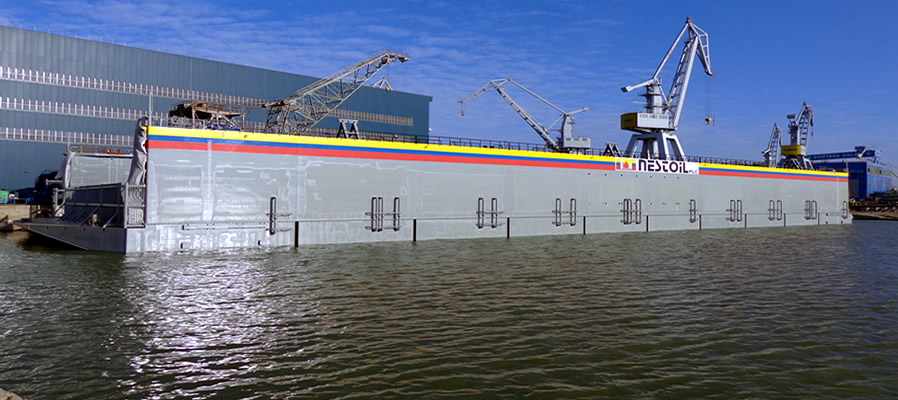- Debts: Nestoil to Sell Some Shares in Neconde’s OML 42 Asset
The management of Nestoil, the oil service arm of the Obijackson Group, owned by Nigerian business mogul Dr. Ernest Azudialu, is to offload part of its shares in oil mining lease (OML) 42 in the Western Niger Delta, which is operated by Neconde Energy Limited, to pay its debts to banks.
According to Oil+Gas Report, Nestoil holds 80 per cent of Neconde and is the prime mover of its special purpose vehicle (SPV) creation, which took over Shell/Total/ENI’s 45 per cent stake in the acreage in 2012. The remaining 55 per cent is held by the Nigerian National Petroleum Corporation (NNPC) and managed by its exploration and production arm, Nigerian Petroleum Development Company (NPDC).
Explaining the reason for the planned sale of equity by Nestoil, the report noted that creating value from the asset has been an epic struggle. While Neconde paid $585 miliion to buy the 45 per cent, it has found it difficult to reach and maintain optimum output and price to pay back the debts and also fund the needed expansion.
The struggle first started with the NPDC, which was chosen as the operator of the OML 42 field on takeover from Shell and partners. NPDC’s alleged inefficiency and struggle for the operatorship of the asset kept production at a very suboptimal level of less than 20,000 barrel per day (bpd) for over three years.
Besides, within the same period of struggle for the operatorship of the field, crude oil price crashed and worsened a bad situation and the Niger Delta militants struck and bombed the crude evacuation pipeline of the field, the Forcados pipeline, forcing the terminal to shut down for 16 months between February 2016 and June 2017.
However, out of the $585 million paid for the asset, the consortium partners (Nestoil, Yinka Folawiyo and KOV) paid $435 million as equity and collectively raised $150 million as debt, but what’s not clear is how much of the $435 million equity was raised as debt by the members of the SPV.
Efforts made by us for further clarifications from the Managing Director/Chief Executive Officer of Neconde Energy, Mr. Frank Edozie, did not yield any fruit as calls and short messages sent to him were not responded to.
But last year, Obijackson Group Chairman, Dr. Ernest Azudialu and Mr. Edozie, at a press briefing in Lagos, lamented the huge financial challenges facing Neconde Energy following the hiccups faced by the downturn in the global oil gas industry since 2014. The challenges, especially crash in price coupled with security issues in the Niger Delta and struggle for operatorship, which stalled production increase, made it difficult to operate profitably to pay the banks.
At a press briefing meant to alert the public of the plans by Petroleum and Natural Gas Senior Staff Association of Nigeria (PENGASSAN) to picket Neconde Energy, following labour issues within the company, the management decried PENGASSAN’s action, considering the enormous challenges already facing the firm.
Azudialu said the Neconde employees, including those that had left the company, wanted transfer allowances for being transferred to Delta State where the oil field is located while the $558million borrowed from Nigerian banks and other international finance firms to acquire the asset have not been repaid in its and another loan, which is almost the same amount used to repair the facilities and interests are only being serviced. Therefore, the employees, who want to leave the company should take the company’s existing severance package.
According to Edozie, the potential production from the asset was 100,000 barrels per day (bpd) at the time of purchase, but on completion of the acquisition, production was about 52,000 bpd. Following the long battle for operatorship of the field, attacks on oil facility, especially the blowing up of the Forcados pipeline on February 13, 2016, which is the only means of transporting oil from the fields to the terminal, production dropped to zero. He added that the firm has started to ramp up production and expects to increase output to 70,000bpd.


 Billionaire Watch3 weeks ago
Billionaire Watch3 weeks ago
 Startups4 weeks ago
Startups4 weeks ago
 News4 weeks ago
News4 weeks ago
 News4 weeks ago
News4 weeks ago
 Bitcoin4 weeks ago
Bitcoin4 weeks ago
 Naira4 weeks ago
Naira4 weeks ago
 Forex3 weeks ago
Forex3 weeks ago
 Treasury Bills4 weeks ago
Treasury Bills4 weeks ago
























